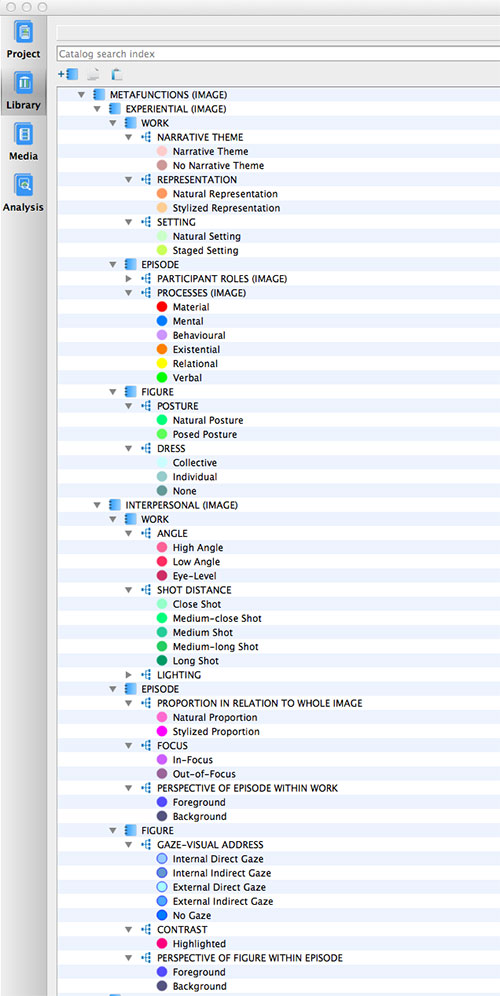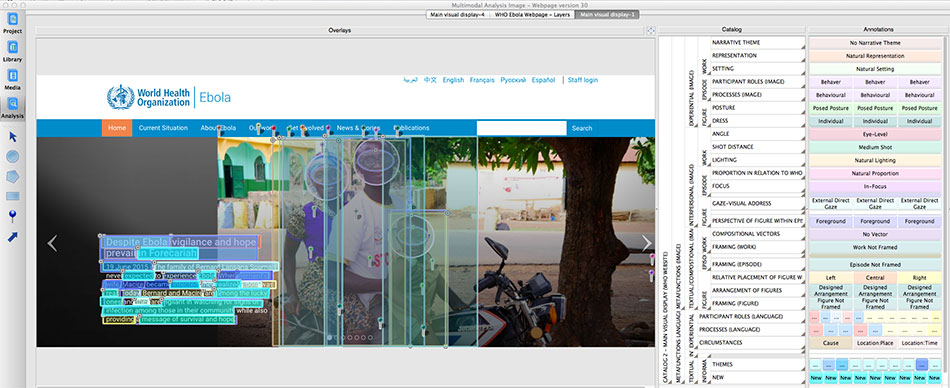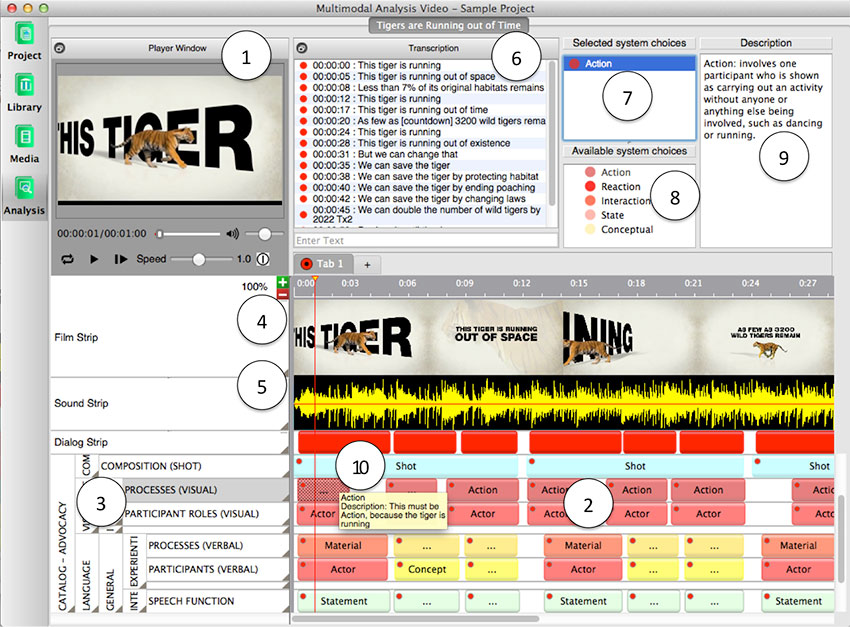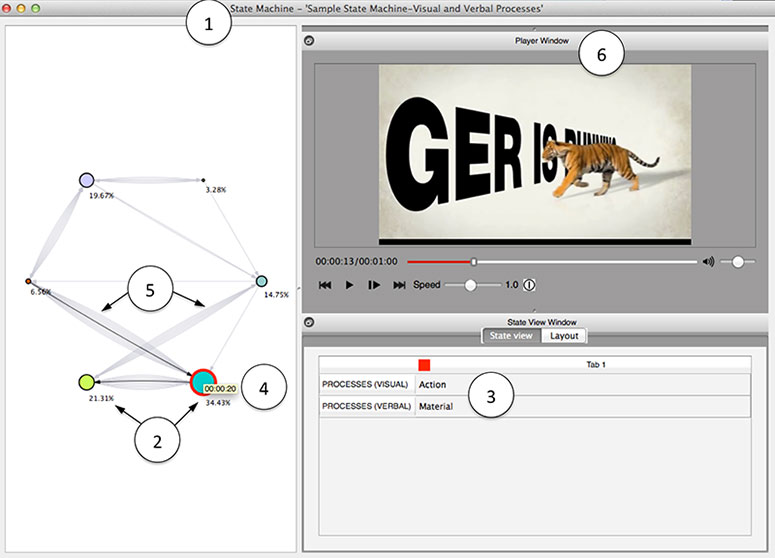Resources
Unit 3: Systemic Functional Linguistics
Chapter overview
Learning objectives
This study unit will help you to:
- Engage critically with a systemic functional approach to multimodality
- Familiarize yourself with the key principles and concepts of systemic functional theory (SFT)
- Try out some basic systemic functional multimodal discourse analysis (SF-MDA)
Overview of Chapter 3
Topics
- The origins and early development of systemic functional linguistics (SFL) and how it has been adapted for the study of multimodality
- Key principles and concepts in systemic functional theory (SFT)
- Methods and analysis in systemic functional multimodal discourse analysis (SF-MDA)
- Fields of application, limitations, potentialities and challenges
Summary
In Chapter 3, we discussed the background and origins of systemic functional linguistics (SFL) developed by Michael Halliday and extended by Ruqaiya Hasan, Christian Matthiessen, Jim Martin and others. We explained how language is viewed as a social semiotic resource for making meaning in SFL. We discussed how the functions that language serves in society are reflected in its underlying organization. From this perspective, we explained that a major aim is to provide a functional grammar to account for the meaning making potential of language. We explained that systemic functional theory is a theory of meaning, and as such, the fundamental principles of the approach apply to the study of other semiotic resources. We used the term systemic functional theory (SFT) to refer to the higher order principles that apply to systemic functional multimodal discourse analysis (SF-MDA), and we used SFL to refer to the application of SFT for the study of language. We discussed how SF-MDA is a sub-field of social semiotics, which is concerned with the systematic organization of semiotic resources as tools for creating meaning in society.
We explained that each semiotic resource has its own systems of meaning, units of analysis and structure, and that meaning arises as a result of semiotic combinations, where the whole is other than the sum of the parts. We introduced the following concepts as part of this discussion:
- Function refers to the four strands of meaning, called metafunctions, which semiotic resources realize: (1) experiential meaning: to construct our experience of the world; (2) logical meaning: to logically connect happenings in that world; (3) interpersonal meaning: to enact social relations and create a stance to the world; and (4) textual meaning: to organize messages. The metafunctional principle plays an important role for understanding the functionalities and underlying organization of semiotic resources and investigating the ways in which semiotic choices combine and interact to create meaning in multimodal phenomena.
- System refers to the systems of meaning through which semiotic resources fulfil the four metafunctions. Each semiotic resource has its own functionalities and systems of meaning. The systems are represented as system networks of options.
- Register and genre are two key concepts in SF-MDA. Register is used to interpret the meaning of multimodal texts and processes in relation to the context of the situation: the nature of the activity (the field), the social relations in terms of the dimensions of power and solidarity (the tenor), and the composition and information flow of the message (the mode). Genre is derived from the configurations of tenor, field and mode, which unfold as social processes in a given culture. Multimodal patterns are built up culturally over time, so that any instance of multimodal semiosis is conditioned by previous configurations of choices, and these need to be taken into account in SF-MDA.
- Multimodal systems, processes and texts are the important dimensions of SF-MDA, where the principles of ‘system’ and ‘text’ encapsulate the two major aims of the approach: (a) to model the meaning potential of semiotic resources as sets of systems; and (b) to analyse the meaning arising from the semiotic interactions in multimodal processes and texts according to context.
- Intersemiosis and resemiotisation are two major processes for SF-MDA. Intersemiosis refers to the interaction of semiotic choices through which meaning is derived. Resemiotisation refers to the re-construal of semiotic choices within and across multimodal phenomena. These two processes explain how meaning expansions occur multimodally, and why different resources are accessed at different times.
The chapter then described the key methods, explaining how the SF-MDA approach involves developing metafunctionally organized systems, analysing the text according to the system choices that are selected and interpreting combinations of choices according to register and genre. We gave examples of systems for language and images and demonstrated sample analyses of texts, images and videos using multimodal analysis software. We discussed the fields of application and noted the limitations of the approach and directions for future research.


Study questions
Read Chapter 3 and answer the questions below. Make notes of your responses and review them when you have completed the study guide.
- How are the concepts of ‘function’ and ‘system’ used in SF-MDA?
- In your view, what is the difference between the meanings made by language, images and music?
- Reflecting on Example 3.3 (pages 41–42), how does mathematics make meaning, and why do you think it is difficult for people to learn?
- A video analysis is presented in Example 3.4. How would you analyse a video?


Exercises
Exercise 3.1: Working with key concepts
- Select a paper from one of the suggested readings for Chapter 3.
- Which of the theoretical concepts discussed in Chapter 3 are used in this paper (e.g. system, metafunction, register and genre, intersemiosis and resemiotisation)?
- How are these theoretical concepts used in the analysis?
- In your view, are the analytical claims justified?
- Would you have come to a different conclusion? How and why?
Exercise 3.2: Exploring visual semiosis
Analyse a famous painting (e.g. Mona Lisa, The Last Supper, Starry Night, the Scream etc) using the systems for images listed in Table 3.1
- Construct a list of possible system choices for each system
- Analyse the painting using this framework
- How does the painting create meaning?
- Can you explain why the painting is famous, based on your analysis?
Read Chapter 1 from Michael O’Toole’s (2011) The Language of Displayed Art.
Exercise 3.3: Exploring multimodal semiosis
Select any instance of a multimodal process or text (e.g. print text, video, website) and:
- List the semiotic resources that are used to create meaning.
- Describe the functions of each resource. That is, which resources are used for what purposes?
- How would you describe the capabilities of the different semiotic resources in this case?
- Which semiotic combinations seem critical?
Tip: The metafunctions can be useful to help describe the uses of the semiotic resources.
Suggested resources
Key readings
O’Halloran, K. L. (2011). Multimodal discourse analysis. In K. Hyland & B. Paltridge (Eds.), Companion to Discourse Analysis (pp. 120–137). London: Continuum.
O’Halloran, K. L., & Lim, F. V. (2014). Systemic functional multimodal discourse analysis. In S. Norris & C. Maier (Eds.), Texts, Images and Interactions: A Reader in Multimodality (pp. 137–154). Berlin: Mouton de Gruyter.
Further reading
O’Halloran, K. L. (2015). The language of learning mathematics: a multimodal perspective. The Journal of Mathematical Behaviour,40: 63–74
O'Toole, M. (2011). The Language of Displayed Art (2nd ed.). London & New York: Routledge.
Online resources
Multimodal Analysis Image software for annotation and analysis of videos
Reference
O’Toole, M. (1994). The Language of Displayed Art. London: Leicester University Press.